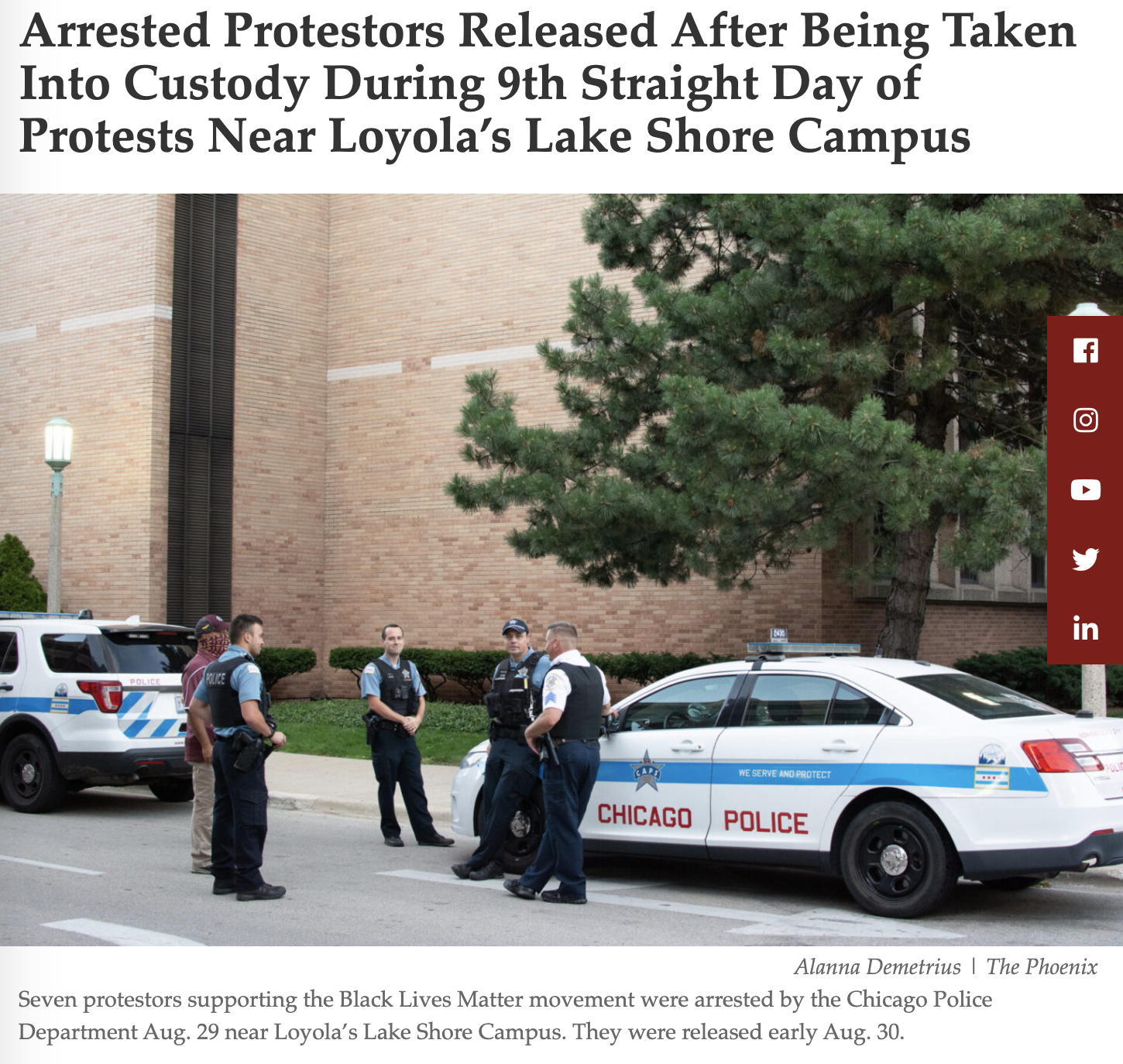The Lead is a weekly newsletter that provides resources and connections for student journalists in both college and high school. Sign up here to have it delivered to your inbox every Wednesday morning.
By Mary Chappell
Far too many people don’t understand how news reporting works — our goals and our missions and our jobs. That was never more clear than Aug. 29 and the days following when The Loyola Phoenix, Loyola University Chicago’s student newspaper, covered ongoing protests supporting Black Lives Matter at the university.
These protests are happening at many other universities around the country. With a looming presidential election that could further escalate unrest in the U.S., I wanted to share a situation I faced nearly a month ago as The Phoenix’s editor-in-chief and provide some guidance for other papers dealing with similar scenarios.
Seven people — six of whom were Loyola students — were arrested Aug. 29 near Loyola’s Lake Shore campus during a protest supporting the Black Lives Matter movement. They were released from police custody early Aug. 30.
The protests have taken place on and around campus since Aug. 21. Protestors have called for Loyola to better support Black students and cut ties with the Chicago Police Department, among other things.
Authorities told The Phoenix the Aug. 29 protestors — who had locked arms and blocked traffic near campus — were told to disperse several times but they refused, leading to arrests. Student protestors at the event also told The Phoenix the police needlessly threw them around. Our reporters gathered and reported both sides of the story.
As Loyola’s student publication, we’ve had reporters covering nearly every moment of every demonstration over the past month. The Phoenix has been there through all phases of this movement to accurately report what’s been happening. As journalists, we have a duty to cover protests, movements and really anything through the good, the bad and the ugly, as I noted in a similar column I wrote to explain our decisions.
And things turned ugly when we posted videos of students being taken into police custody on our Twitter on Aug. 29. We were subsequently contacted by dozens of people, calling for us to strip the videos from our social media, with some people saying the publication brought participants unnecessary trauma. When we didn’t comply with the requests, members of the movement called for a moratorium on talking to Phoenix reporters about the events.
People spread photos and memes with the words “F— The Loyola Phoenix.”
The Phoenix later published a story detailing the protests and arrests, with the names and charges of those taken into police custody.
Then, we were berated online and on social media for posting the detailed and accurate story of what occurred and for keeping the videos up.
Like most campus media, The Phoenix is editorially independent of the university and doesn’t directly support anyone or anything except the pursuit of the full truth. We aren’t on the students’ side. We aren’t on the university’s side. Our sole job is to side with complete and full accuracy. Our job isn’t to be a promoter; it’s to cover things as they are.
Our reporters posted videos of the arrests on social media because they occurred in a public space. We don’t need consent for videos or photos taken of people in public. We didn’t take them down because that’s not what media outlets typically do. If something is blatantly wrong or inaccurate, we publish a correction. But nothing was inaccurate here.
The names and charges accessed by The Phoenix through Chicago police are public record and can be accessed and seen by the public and reporters.
Students participating in the movement complained The Phoenix had “been continuously harassing the 7 people who were arrested.” For any story, we give all parties involved a fair chance to give their perspective. This may include repeated phone calls, direct messages, etc. that are polite, not harassing. It was important to us to make sure everyone arrested had a fair chance to speak up about what happened, so naturally we sent follow-up interview requests to all.
We did what was right, and we won’t stop doing this now for this movement or any other coverage. We are ethically bound to make sure people are notified and have a chance to speak toward their direct involvement in any story.
These policies are not just ours. They’re used by a number of other journalists and well-thought-of media outlets we deeply respect.
We’re trying to do our jobs the best we can — fairly and accurately, as always. We’re going to keep doing the best we can to cover what needs to be covered. We’re in a tough spot as student journalists with some of our peers taking part in demonstrations and putting pressure on us — but at the end of the day, we have a job to do.
With a country in this state, the worst thing to do is kill the messenger — especially when the messengers are student journalists.
Mary Chappell is the editor-in-chief at the Loyola Phoenix, Loyola University Chicago’s student newspaper. She’s a multimedia journalism major and is from Denver, Colorado.
One story worth reading
The Los Angeles Times is examining its own institutional history through the lens of race in an impressive package of stories and opinion pieces. The Times examines the paper’s treatment of people of color in coverage and inside the newsroom. “An organization should not be defined by its failures, but it must acknowledge them if it is to hope for a better future,” the editorial board writes. Student journalists should consider examining their own history of covering communities of color in order to work toward their own better future.
Internship application season begins
Applications are already open for some news organizations’ summer 2021 internships. The Lead will have a full database available soon, but to get you started, a few with earlier deadlines:
- The Washington Post (Oct. 7)
- The Oregonian (Oct. 14)
- The Baltimore Sun (Oct. 15)
- South Florida Sun Sentinel (Oct. 15)
- The Dallas Morning News (Oct. 30)
- The Texas Tribune (Oct. 30)
- The Wall Street Journal (Oct. 30)
- Austin American-Statesman (Oct. 31)
- Bloomberg News (Oct. 31)
- Pulliam Journalism Fellowship (Nov. 1)
- The Boston Globe (Nov. 1)
- Tampa Bay Times (Nov. 1)
- Sports Journalism Institute (Nov. 2)
- Dow Jones News Fund (Nov. 9)
- The Virginian-Pilot (Nov. 13)
Opportunities and trainings
- The Nation is hosting a free virtual student journalism conference on Oct. 9. Register here by Oct. 2.
- Apply for WBUR public radio’s yearlong newsroom fellowship by Oct. 9.
- Register for the Adobe MAX conference, a free virtual event from Oct. 20-22 featuring speakers on design, illustration, video and more.
- Registration is now open for this year’s virtual ACP/CMA conference, Oct. 22-24.
- College students, enter the Reynolds Journalism Institute’s Student Innovation Competition by Oct. 31.


Taylor Blatchford is a journalist at The Seattle Times who independently writes The Lead, a newsletter for student journalists. She can be reached at blatchfordtaylor@gmail.com or on Twitter @blatchfordtr.







